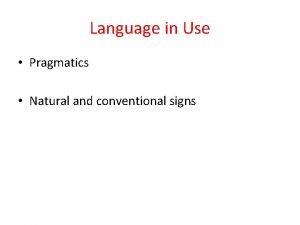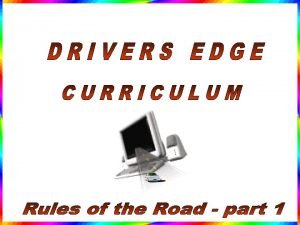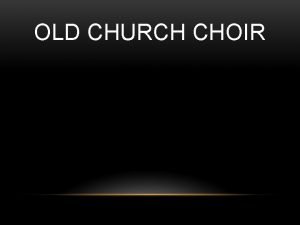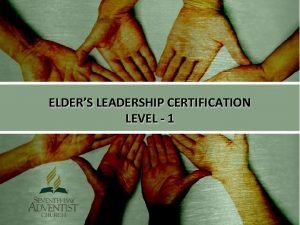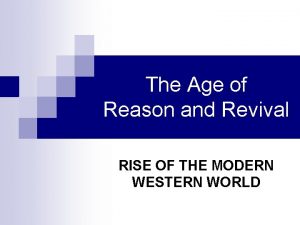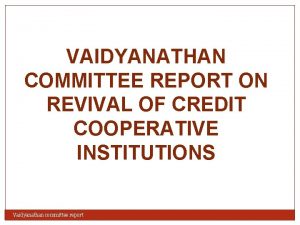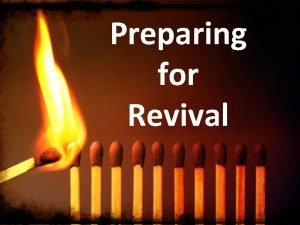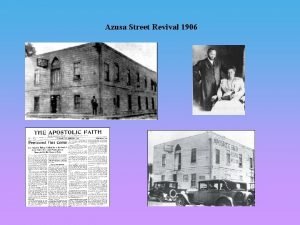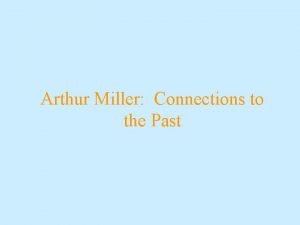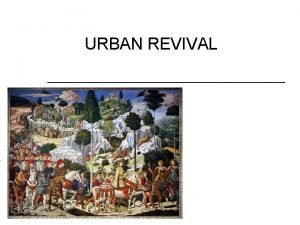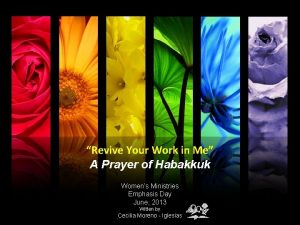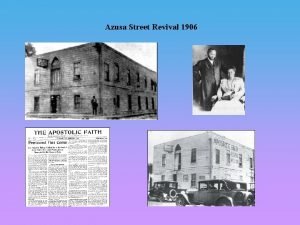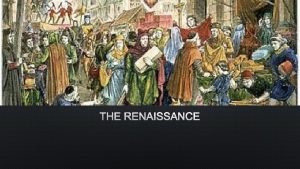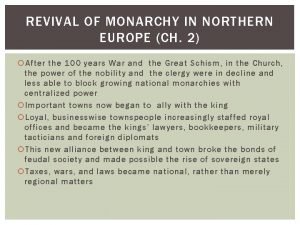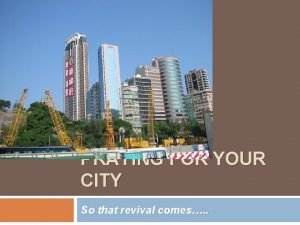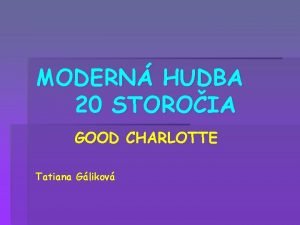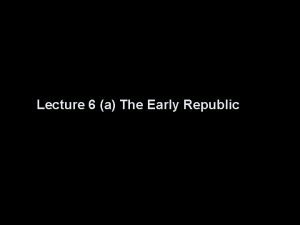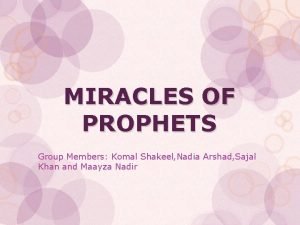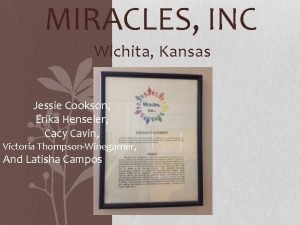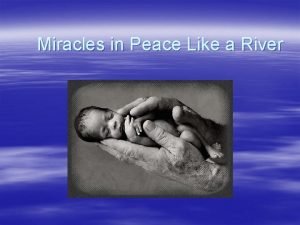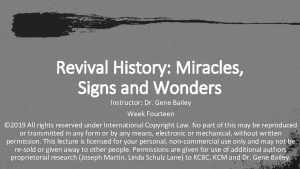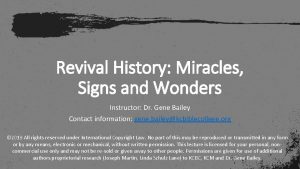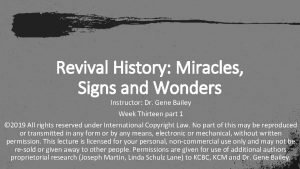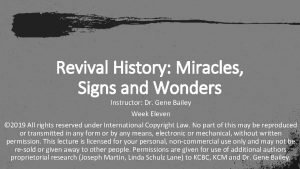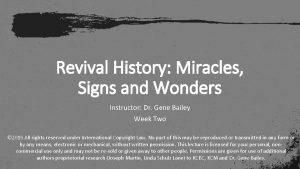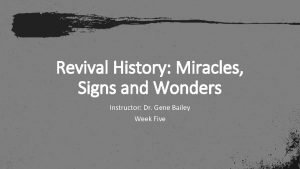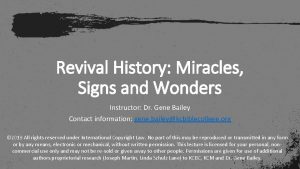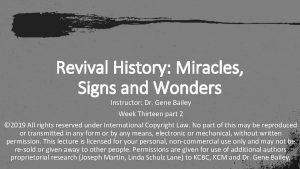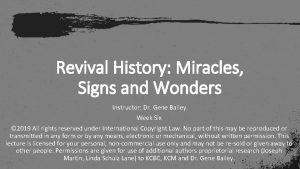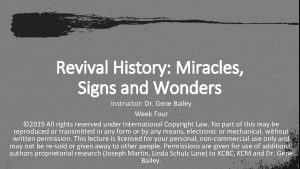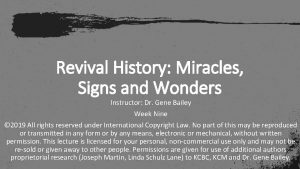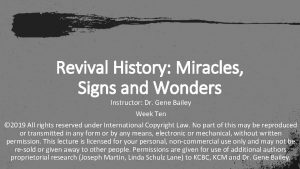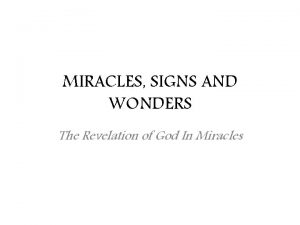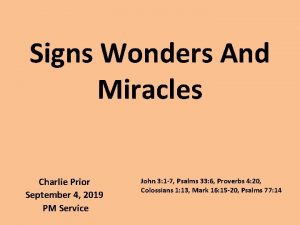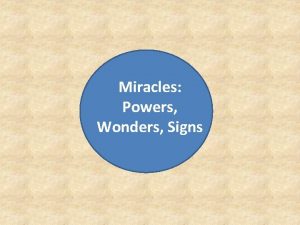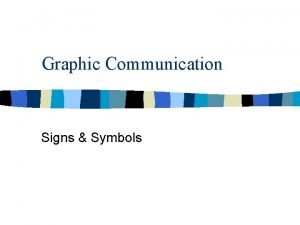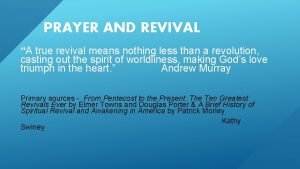Revival History Miracles Signs and Wonders Instructor Dr






![• Movements [revivals] do not happen by chance. A movement of prayer accompanied • Movements [revivals] do not happen by chance. A movement of prayer accompanied](https://slidetodoc.com/presentation_image/04f8777b48345e30b573002e84b70571/image-7.jpg)

























- Slides: 32

Revival History: Miracles, Signs and Wonders Instructor: Dr. Gene Bailey Week Five © 2019 All rights reserved under International Copyright Law. No part of this may be reproduced or transmitted in any form or by any means, electronic or mechanical, without written permission. This lecture is licensed for your personal, non-commercial use only and may not be re-sold or given away to other people. Permissions are given for use of additional authors proprietorial research (Joseph Martin, Linda Schulz Lane) to KCBC, KCM and Dr. Gene Bailey.

England had political restlessness • great moral decay and spiritual darkness • No police force. Mobs ransacked London and Birmingham burning homes opening prisons and terrorizing people • Prisons were awful --“rats and insects were everywhere. One man took a dog into prison to protect him from the vermin – the vermin killed his dog” Deism took hold of England(1600 -1670) Authority of the Bible shaken • Deism said God existed but no personal dealing with man – denied all miracles including the Virgin Birth –Many people ended up dropping out from church because of this

• England made it illegal to own a Bible and a fine or jail time if you did not attend their state church. • As these photos show, this recreation of Benjamin Franklin’s coffee/tea table shows where the family hid their Bible. • England has had many times of Revival that birthed groups like Quakers, Puritans and Separatists.

Children and grandchildren of the Puritan Awakening commanded the scene during the mid 1700’s • The only fire found was in the Puritans • England had forbidden Puritan ministers from preaching, “the old lights and the new lights” • Churches had to be located 7 miles from the city • Most prominent statesmen were unbelievers and were known for grossly immoral lives, drunkenness, and foul language. • Marriage was laughed and sneered at. Lord Chesterfield’s famous letters were written to educate his son how to seduce women

Anglican Clergymen • Basically unsaved often were illiterate • Many didn’t use a Bible to preach from • Many clergymen did not even live near the churches that the state appointed them to. • Many were drunkards and experts in every type of vice • They enjoyed the revenue and didn’t even see their parishes • Religion was a code of ethics instead of a spiritual experience • Clergy was mere figureheads who opposed the doctrine of salvation. House of Commons: No more than 4 or 5 members of the House of Commons attended church Schools: For the elite. The common people in pre-Revival England were for the most part ignorant and brutal.

• While the Puritans did not openly remove from the Church of England as the Separatists and William Bradford (who settled in Plymouth 1620) did , in practice the two groups held the same values and practices. • The Puritans once saved began working on “purifying the church”. • There were many unscriptural ceremonies and practices in England’s state Anglican church that Puritans wanted ousted or “purified”. • For example, in England there were 160 actions that were declared to be liable to death – that is instant death such as chopping down a cherry tree, stealing money[40 shillings from a house and 5 shillings from a person] • One court session produced 40 -50 hangings at once • Puritans saw their covenant with God the reason to enact reforms. Their detractors saw them as hairsplitters who slavishly followed their Bibles as guides to daily life. • Compassion for the poor and practical helps came from Puritans, in this era. At a time where a priest held absolute power and often were illiterate (how can you make a meaningful sermon if a priest was illiterate and didn’t read the Bible), the Puritans pushed for education and literacy. •
![Movements revivals do not happen by chance A movement of prayer accompanied • Movements [revivals] do not happen by chance. A movement of prayer accompanied](https://slidetodoc.com/presentation_image/04f8777b48345e30b573002e84b70571/image-7.jpg)
• Movements [revivals] do not happen by chance. A movement of prayer accompanied the revival that brought the power of God in flames of repentance. • GOD LOOKED FOR “GAP AND HEDGE ATTENDANT” Ezekiel 22: 30 New International Version "I looked for someone among them who would build up the wall and stand before me in the gap on behalf of the land so I would not have to destroy it, but I found no one King James Bible And I sought for a man among them, that should make up the hedge, and stand in the gap before me for the land, that I should not destroy it: but I found none.

• BUT - GOD FOUND A GERMAN NAMED COUNT ZINZENDORF • THUS THE MORAVIAN REVIVAL STARTED • THIS CAUSED OTHERS TO GO TO THE FRONT LINES OF REVIVAL …. . • JOHN AND CHARLES WESLEY, GEORGE WHITEFIELD, LADY HUNTINGTON, JOHN ERSKINE, JONATHAN EDWARDS AND OTHERS WHO LITERALLY CHANGED THE WORLD • A SCOTTISH PRESBYTERIAN MINISTER BY THE NAME OF JOHN ERSKINE BEGAN TO WEEP OVER THE CONDITION OF HIS NATION

• HE EMERGED FROM HIS PRAYER CLOSET AND WROTE A PAPER PLEADING WITH THE PEOPLE OF SCOTLAND ELSEWHERE TO PRAY FOR A REVIVAL OF RELIGION • JOHN ERSKINE SENT A COPY OF THIS PLEA TO JONATHAN EDWARDS IN NEW ENGLAND - HIS HEART WAS DEEPLY STIRRED - SO HE PREPARED A RESPONSE - SO HE PUBLISHED A FORM OF IT

Count Nicholas Von Zinzendorf (1700 -1760) • Count Zinzendorf was born into Austrian nobility • Had a passionate love for Christ • He learned the secret of prevailing prayer at an early age • As his prayer life grew and passion for God --his passion to win the lost grew also • Established 7 “Circles of Prayer” while in college at the age of 16 •

John Hus (1369 -1415) • The Moravians were founded by the martyr named John Hus • He lived a century before the Reformation and Martin Luther’s 95 Theses. His steadfast commitment in the face of the church’s cunning brutality inspired them. • "I had thought to become a priest quickly in order to secure a good livelihood and dress and to be held in esteem by men. "

John Hus (1369 -1415) • He earned a bachelor's, master's, and then finally a doctorate. • A priest --yet the Bible was not his core study resource –it had to be “discovered” in a library. • Hus was horrified: Two men were vying to be pope and used selling of “indulgences” (paying cash forgiveness of a sin) to fund their armies. The king took a “cut” of the money.

John Hus (1369 -1415) • He proclaimed the Bible as final authority and wanted services to be in the Czech language not just Latin • He said Czechs were being exploited by pope “indulgences” which swiped at the king too • He was ex-communicated and wrote treatises explanations • The Council arrested him, and he would be burned at the stake. He recited the Psalms as the flames engulfed him.

The Moravians • Some came out of the group Bohemian Brethren that was inspired by John Huss. They had been living in Northern Moravia, were severely persecuted, and many were also martyrs Count Zinzendorf owned large sections of land in Saxony • 1720, he gave this small group of people refuge on one of his estates near Dresden, Saxony or Germany • The place became known as Hernhut (The Lord's Watch) • Some immigrants added were from the very successful “Children's Prayer Revival” in Silesia (1707)

The Moravians • During the years here there rose within the village: disunity, strife, quarrels, etc. The community became greatly divided. Count Zinzendorf had them find things that they agreed on • Remember prayer proceeded Pentecost! There were some people who prayed , at least (2) years • May 12, 1727 the Brotherly Agreement is adopted • July 16, 1727: the Count poured out his heart with a flood of tears – his tears so affected the rest of the village July 22: many made a covenant on their own to pour out their hearts in prayers and hymns

The Moravians Aug 13: This day was a specially called Communion service – • The Holy Spirit poured out on all - His Presence fell on the place • Prayers were answered in ways beyond anyone's expectations • Many people started to set time aside in earnest prayer • This was the start of the Moravian Prayer Revival • They became a happy people

The Moravians Aug 26: 24 men and 24 women covenanted together to continue in intervals of 1 hour each - they continued in earnest prayer Aug 27: with the new prayer regulation others joined in and it increased to 77 people • They carefully observed the hour that was appointed them Children also started prayer • They organized from the littlest ones to form a prayer chain • These children became known for their prayers and their effectiveness Prayers went on for 100 years - 24/7

The Moravians recognized themselves in debt to the world, trustees of the gospel. • They were taught to embrace a lifestyle of self-denial, sacrifice and prompt obedience • They followed the call of the Lamb to go anywhere and with an emphasis upon the worst and hardest places as having the first claim The Count was determined to evangelize the world with a handful of saints equipped with a burning love for Jesus and the power of Prayer

The Moravians • Established more than 30 settlements internationally on the Herrnhut model, which emphasized prayer and worship, and a form of communal living in which simplicity of lifestyle and generosity with wealth were held to be important spiritual attributes. • Spinning, weaving, carpentry, pottery, farming and missionary training went on unceasingly. Each evening Zinzendorf selected a scripture to be the watchword for the next day. Often he wrote a hymn to accompany the word. • With predating the Reformation, Moravians were considered the first “Protestants”. • They were first Protestant church body to begin missionary work • They formed many hundreds of small renewal groups operating within the existing churches of Europe, known as "diaspora societies". These groups encouraged personal prayer and worship, Bible study, confession of sins and mutual accountability. While you owned your own property Another common characteristic of the Moravians were that they had all things in common

The Count's motto became: "I have one passion; it is He and He alone" • Although in 1727 they did not set out to do missionary work - the Count on a trip to Copenhagen met up with natives from Greenland the West Indies - they pleaded for missionaries to be sent--First missionaries were sent to St, Thomas and the Virgin Islands in 1732 • John Leonard Dober a potter and David Nitschman a carpenter --their cry as they sailed away: "May the Lamb that was slain receive the reward of his suffering" • In 1732, the Moravian congregation in Herrnhut, Saxony was about 300 strong and sent out their first missionaries to the West Indies. Within fifteen years, the Moravian church had sent out hundreds of missionaries and had established churches on every continent. The missionaries were all supported by prayer. • Within fifty years, the Moravians had established churches in St Thomas, St Croix, St John’s, Barbados, Antigua and St Kitts, and over 13, 000 converts were baptized.

Moravian Missionary Timeline 1733 -1760 • 1733 Greenland • 1734 St. Croix and the Virgin Islands - ten of this group died but they sent replacements • 1735 Surinam • 1737 South Africa • 1740 North American Indians • 1754 Jamaica • 1756 Antigua • From 1732 to 1760 they sent 226 missionaries to 10 locations

• Their labors bore fruits - soon there were 3 people to every person at home • Many sold themselves into slavery to be able to preach the gospel to that group of people • These were people who were men with little formal education, but they were men of passion and piety • They realized through revival - they experienced God's heart - that is the evangelization of the world • Once the church is set in order then the church goes out and sets the world into order (the hearts of men) • Within 20 years they has started more missions than the Anglicans and Protestants had started in the proceeding 200 years

• The Count became determined to evangelize the world with a handful of saints, equipped only with a burning love for Jesus and the power of prayer • Today's methods with $$$$, technology and other things - we are doing a sub-standard job compared to what the Moravians did! Why? • The heart! • They followed the call of the Lamb to go anywhere and with emphasis upon the worst and hardest places as having the first claim. • No soldiers of the cross had ever been bolder as pioneers, more patient or persistent in difficulties, more heroic in suffering, or more entirely devoted to Christ and the souls of men than the Moravian Brotherhood. •

Moravians- Consider this • • https: //www. youtube. com/watch? time_continue=39&v=ixiu. E_Nb 6 D 0

Saving slaves for Jesus • • https: //www. youtube. com/watch? time_continue=14&v=du. U 5 Fz. DYn 7 s

History --the Moravians! • • https: //www. youtube. com/watch? v=x. Rs 9 Yk. Cv. M_8

PRAYER LEADS TO REPENTANCE --Be the Revival of your own life-REPENTANCE LEAD TO REVIVAL - People get hungry for MORE - REVIVAL LEADS TO SOULS - MORE, MORE •

Famous Moravian convert: John Wesley • 5’ 6” 120 lbs, neat in dress, “his eye was the brightest and most piercing you can conceive” • 15 sermons a week, 46, 000 sermons in his career • 226, 000 miles of travel, traveled 7 days a week, prayed at least 2 horses from lame to whole • Sermons brought conversions, “fits” and “trances”. • He celebrated Christmas sharing sermons on how to be charitable. To a nation seeped in vices, he taught about kindness, seedtime and harvest and making Christmas especially a season of Charity (giving). While we know love is much more than a financial gift of help, to the babies in John’s ministry, giving in love was radical. Today we have “charities” that offer free helps, an idea John birthed for his nation and America. • John never formally withdrew from the Anglican church. • When he died age 88 (1791) he left a changed England


• At Oxford, John and Charles Wesley created the “Holy Club”. • It was all about works! George Whitefield who was so poor he had to be a servitor to the rich students also was in this club. • John Wesley did a mission's trip to the colony of Georgia to convert the heathen. Not being saved himself, his core message was about earning your way to heaven. • On the boat a fierce storm emerged that caused many to fear for their lives. The Moravians aboard simply prayed and praised God. John Wesley couldn’t believe it! • Asking a Moravian about this radical response, he was introduced to the idea of the New Birth. • At the colony of Georgia, John Wesley met, fell in love with a lady, got engaged, and decided not to marry her. She brought charges of broken engagement. To avoid punishment, he fled to England. • He couldn’t let loose of the idea of New Birth. At the Moravians church Aldersgate, he accepted Christ

• JOHN WESLEY WAS A HIGH PULPIT PREACHER WITH FANCY WORDS AND POLISHED STYLE - WHEN HE STARTED TO PREACH THE PEOPLE STARTED TO WEPT AND CRY AS HE PREACHED. HE COMMANDED AN AUDIENCE OF THOUSANDS • IT WAS THROUGH HIS PREACHING THAT WESLEY BEGIN TO TEACH THE PEOPLE IN METHODOLOGY TEACHING AND ORGANIZATIONAL MEETINGS - WHICH LATER BECAME THE METHODIST CHURCH • THIS REVIVAL OF 1735 BROUGHT ABOUT A TRANSFORMATION OF CONDITIONS WHICH REVERSED THE SOCIAL, MORAL AND POLITICAL DECLINES. DEISM [WHICH DENIED THE NEED OF GOD] WAS STOPPED IN ITS TRACKS • An Awakening happened simultaneously in American colonies, England, Scotland Ireland. • It would cause England to avert the bloody French revolution that France was revving up for. •

Gilbert Tennant • GOD RAISED UP GILBERT TENNANT TO START A SCHOOL IN THE WILDERNESS FOR THE INSTRUCTION OF YOUNG MEN FOR MINISTRY • IT BECAME THE LOG CABIN COLLEGE - LATER TO BE NAMED PRINCETON UNIVERSITY - THE GRADUATES FROM THIS SCHOOL GREATLY INFLUENCED THE COLONIES • HE ALSO RAISED UP OTHER SCHOOLS FOR RELIGIOUS TRAINING AS WELL
 All traffic signs and meanings
All traffic signs and meanings Charles finney miracles
Charles finney miracles Signs taken for wonders by homi bhabha
Signs taken for wonders by homi bhabha Language is conventional
Language is conventional What color means motorist services guidance
What color means motorist services guidance The octagon shape is used exclusively for
The octagon shape is used exclusively for There's revival and its spreading
There's revival and its spreading Revival and reformation
Revival and reformation Age of revival
Age of revival Elisha miracles chart
Elisha miracles chart Helnaren
Helnaren Vaidyanathan committee report
Vaidyanathan committee report Preparing for revival
Preparing for revival Azusa street revival 1906
Azusa street revival 1906 Tadah revival
Tadah revival Urban revival
Urban revival Revive your work o lord
Revive your work o lord French era floral design
French era floral design Charles parham
Charles parham What means rebirth in french
What means rebirth in french Monarchy in northern europe
Monarchy in northern europe Prayer for revival in our city
Prayer for revival in our city Moderna hudba 20 storocia
Moderna hudba 20 storocia Ddp revival
Ddp revival Ali hada bara
Ali hada bara Ac61-98 plan of action
Ac61-98 plan of action Virtual instructor art
Virtual instructor art Miracle of hazrat isa
Miracle of hazrat isa Miracles wichita kansas
Miracles wichita kansas Miracles in peace like a river
Miracles in peace like a river 9 miracles of peter
9 miracles of peter Healing miracles of jesus
Healing miracles of jesus Dna miracles diaper cream
Dna miracles diaper cream



